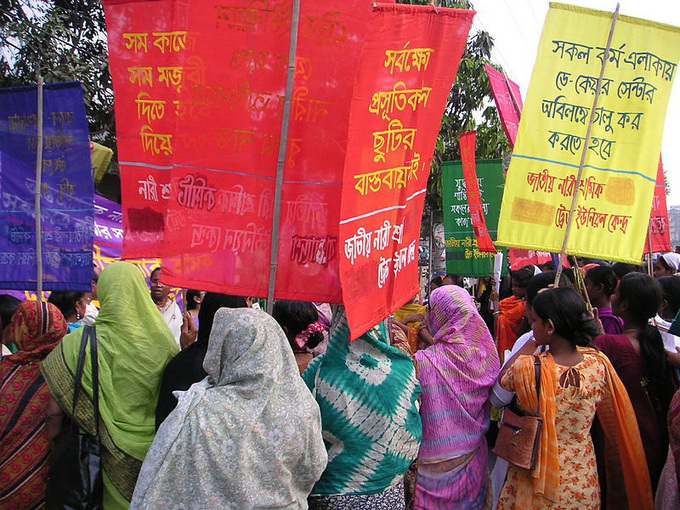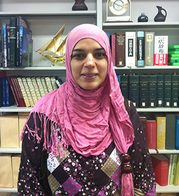A History of Feminism: From the Middle East to the Far East
Safaa Mahmoud Mohamed Nour
Assistant teacher of Japanese Department, Faculty of Arts, Cairo University

Photo: Soman
It was a long trip from the Middle East (Egypt) to the Far East (Japan), just as the long history of women's struggles in the two countries to gain their freedom and rights.
My thesis is concerned with the progress of Western feminism (focusing on British and American feminism), Japanese, and Egyptian feminist thoughts and the leading feminist figures in each country. In this article, I will examine the similarities and differences between the three experiments especially in the first two waves of the feminist movements.
Modernization and feminism in the West, Japan, and Egypt
As it is well-known, "Feminism" is a relatively modern term. It was brought to England through France, and was not introduced to the United States until the 1910s. Afterwards the term spread in many countries and became to be used as it is in many languages including Japanese and Arabic. Also, it is almost agreed to classify feminist movement into two major waves and sometimes into three. According to the Western classification the first wave ranges between the mid-19th century and the early 20th century but many feminists see that the actual starting point goes back to the year 1792 when Mary Wollstonecraft published a revolutionary book titled A Vindication of the Rights of Woman. And the second wave or what we can call a resurgence of feminist activity started in the 1960s.
Comparing to the long and old history of the Western feminist movements, their Japanese and Egyptian counterparts are relatively modern. From my point of view we can't apply the Western classification to the Japanese and Egyptian feminist experiments, since they started after the Meiji Restoration (1868) in Japan, and after Muhammad Ali's reformation (1805) in Egypt.
The Muhammad Ali's Egyptian modernization started before the Japanese Meiji Restoration, but it was suspended due to the British and French colonial ambitions towards the country. For this reason, it can be said that the history of the Egyptian feminist movement is longer than its Japanese counterpart, but due to the circumstances at that time, the movement in Egypt advanced in a very slow pace.
Egyptian Intellectuals who addressed women's issues
After assuming the power of Wali, Muhammad Ali proclaimed the "strong army strong country" policy and started to dispatch delegates to Europe, first to Italy then to France to learn the European technologies. After returning, the delegates tried to change their undeveloped society by introducing the disciplines they had learned from Europe, including science, social thoughts, technologies, economics, etc.
Women and their inferior position in Egyptian society was one of the issues that concerned them. Rifa'a Rafi' al-Tahtawi was the first Egyptian intellectual who brought the women's issues up in his writings and appealed for their rights for education. He was dispatched to France in 1826. At first he was sent with other students as their religious guide (Imam) then afterwards when he demonstrated his brilliance in learning he became a regular student and wrote his famous book Takhlis al-lbriz fi Talkhis Bariz (The Quintessence of Paris). In this book he wrote about all what he had observed and experienced in France. And when he returned back to Egypt after 5 years, he started to introduce the European civilization into his home country and wrote many books. One of his publications titled The Honest Guide for Girls and Boys advocated for girls' education and women's right to work outside her home and choose the one that suits her nature.
Qasim Amin who learned also in France was more audacious than Al-Tahtawi. In 1899 he published The New Woman and Woman's Liberation, and in his writings demanded women's emancipation, proper education and employment opportunities.
Afterwards women, who learned from the returning intellectuals about the Western thoughts on freedom and justice, began to advocate their own rights. One of them was Hoda Shaarawi who actually is considered to be a pioneer of Egyptian feminism and a representative to what we can classify as the first Egyptian feminist wave which began in 1919, right before the end of the first feminist wave in the West.
Feminist movement in Japan
In the meantime, the modernization of Japan started with the end of the Tokugawa Shogunate and the beginning of the Meiji period. Raising the slogan "rich country strong army" or "fukokukyohei," the delegates were dispatched to almost all Western countries including England, the United States, France, Germany, etc. to introduce Western technologies into Japan.
Fukuzawa Yukichi was one of the remarkable Japanese intellectuals who contributed to developing his own country and wrote many books like Seiyo jijo (Conditions in the West), an account of his trips to England, France, Russia, Portugal, Prussia and America. Through his publications and activities, he introduced the Western systems in economy, politics, etc. to Japan. One of his remarkable and influential writings was The Encouragement of Learning in which he advocated for equal treatment between men and women without discrimination and also supported for women's rights. Furthermore, his revolutionary book titled Shin onna daigaku (The New Greater Learning for Women) refuted all the inferior look of the confusian teaching towards women in Onna daigaku (The Greater Learning for Women) which was used for women's education during the Edo period. And as well as Egyptian women, Japanese women learned the Western thoughts on freedom from the returning intellectuals and started by themselves to advocate for their rights. In 1911 "Seitosha" was founded, and its founder Hiratsuka Raicho, Japan's pioneer feminist, promoted to abolish the old conventions toward women, and Hiratsuka also played a leading role in what we can call the first feminist wave in Japan which started right before the end of the Western first feminist wave.
Voting rights were a major demand in the feminist movement in the early 20th century. America and England gained the rights in 1920 and 1928 respectively, while in Japan women finally had that right in 1945, and in Egypt in 1956.
U.S. influence on Japanese and Egyptian feminism
In 1960s, the Women's Liberation Movement started in America after Betty Friedan's influential book The Feminine Mystique was published. This movement spread quickly all over the world and reached Japan around 1970. And Japan saw the emergence of radical feminists like Ueno Chizuko who started to advocate women's rights around that time. On the other hand, we can't clearly trace the influence of this movement on its Egyptian counterpart, but Egyptian radical feminists like Nawal Elsaadawi appeared and started to advocate for women's rights around 1960s.
Thus, we can observe that the first wave in both Japan and Egypt demanded women's rights to be equal to their men's counterparts. In the second wave, women started to construct a world of their own, and various interpretations to the feminist movement emerged with many approaches. After 1960s, we started to see several types: liberal, Marxist, social, and radical feminism. Sometimes we can see the Western impact on both Japanese and Egyptian feminism, but might not be able to find its traces. Japanese feminism was more audacious and radical with the comparison to the Egyptian one, and I think that is natural to have the differences due to different cultural and religious backgrounds. Nevertheless, through a variety of approaches and interpretations we can find the similarities in the goals, which are to liberate women from oppression and abolish any kind of discrimination towards women.
 Safaa Mahmoud Mohamed Nour
Safaa Mahmoud Mohamed Nour
Born in Cairo. Assistant teacher of Japanese Department, Faculty of Arts, Cairo University. Obtained an MA in Japanese Language and Literature from Faculty of Arts at Cairo University. Specialized in Japanese modern thoughts. Will reside in Japan under the Japan Foundation Japanese Studies Fellowship Program (May 2013 - July 2014), and study Japanese feminist thoughts at Institute of Advanced Studies on Asia, the University of Tokyo.
Keywords
- Philosophy/Religion
- History
- Japan
- United States
- France
- U.K.
- Egypt
- Cairo University
- Feminism
- Feminist
- Mary Wollstonecraft
- Meiji Restoration
- Mohamed Ali
- Refa'a Rafea Eltahtawai
- Kasem Ameen
- Hoda Shaarawi
- The Encouragement of Learning
- Seitosha
- Hiratsuka Raicho
- Betty Friedan
- Women's Liberation Movement
- Nawal Elsaadawi
- Liberal feminism
- Marxist feminism
- Social feminism
- Radical feminism
Back Issues
- 2019.8. 6 Unraveling the Maker…
- 2018.8.30 Japanese Photography…
- 2017.6.19 Speaking of Soseki 1…
- 2017.4.12 Singing the Twilight…
- 2016.11. 1 Poetry? In Postwar J…
- 2016.7.29 The New Generation o…
- 2016.4.14 Pondering "Revitaliz…
- 2016.1.25 The Style of East As…
- 2015.9.30 Anime as (Particular…
- 2015.9. 1 The Return of a Chin…

